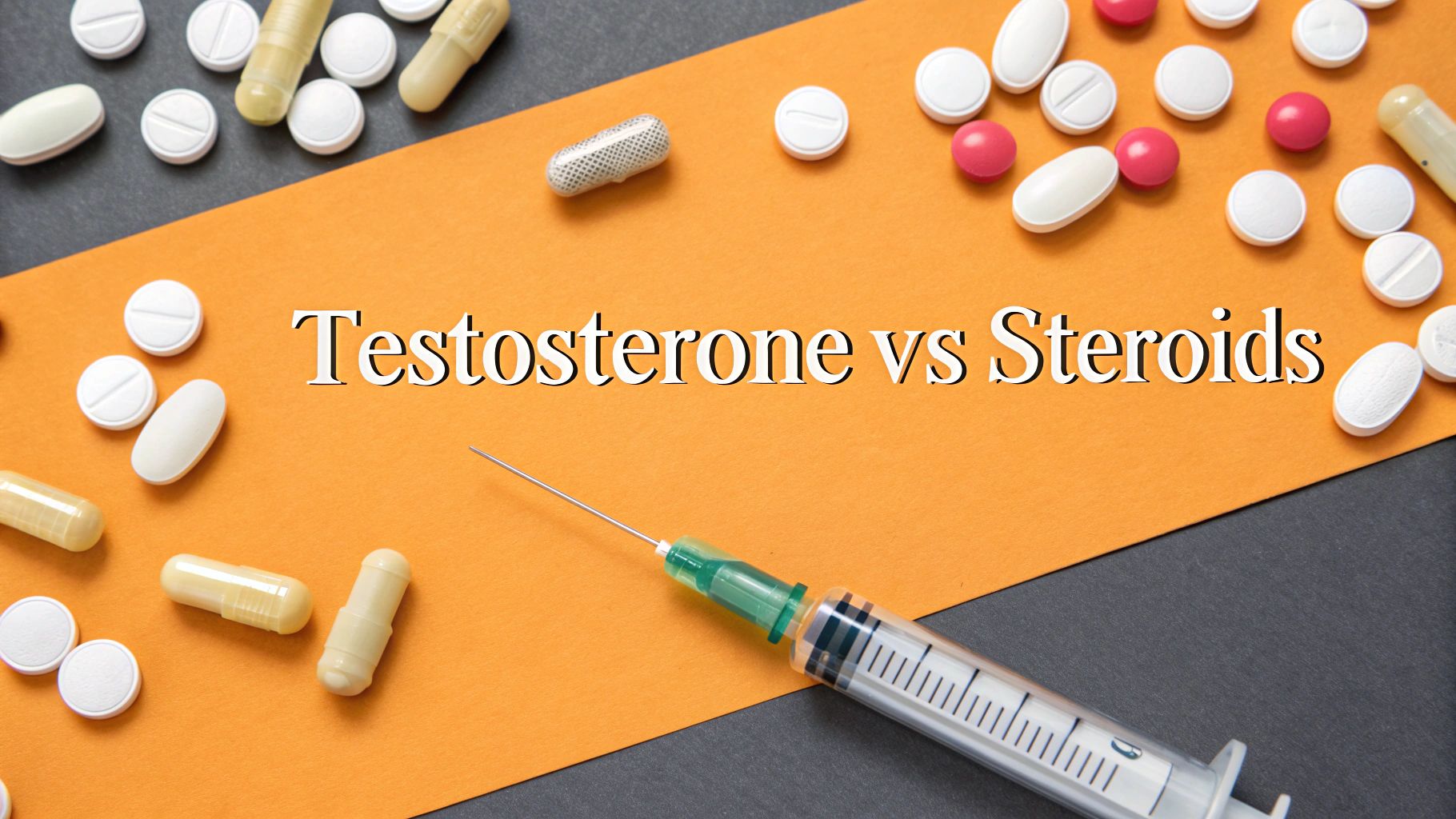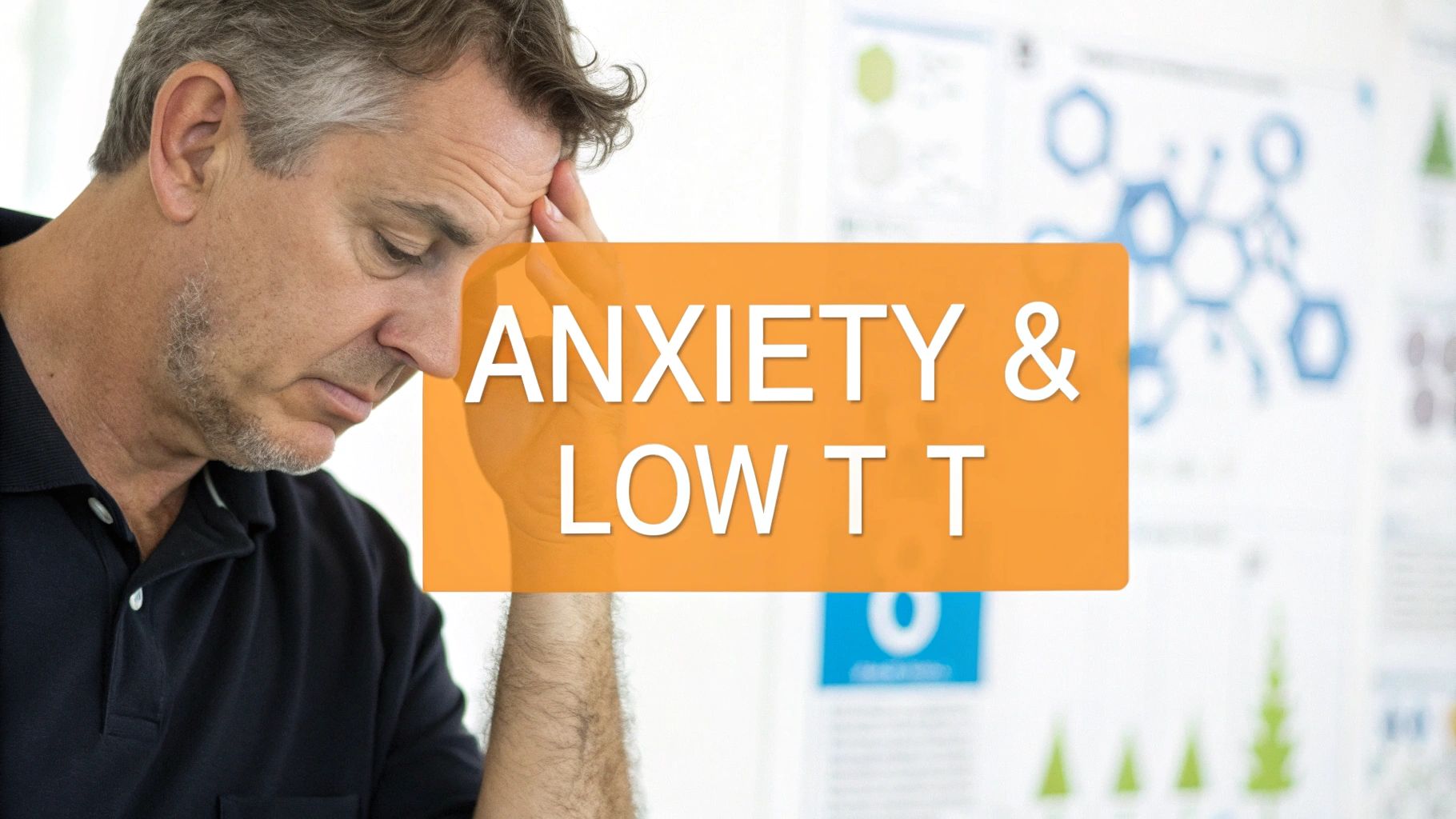Does Hormone Replacement Therapy Cause Hair Loss? Find Out the Truth
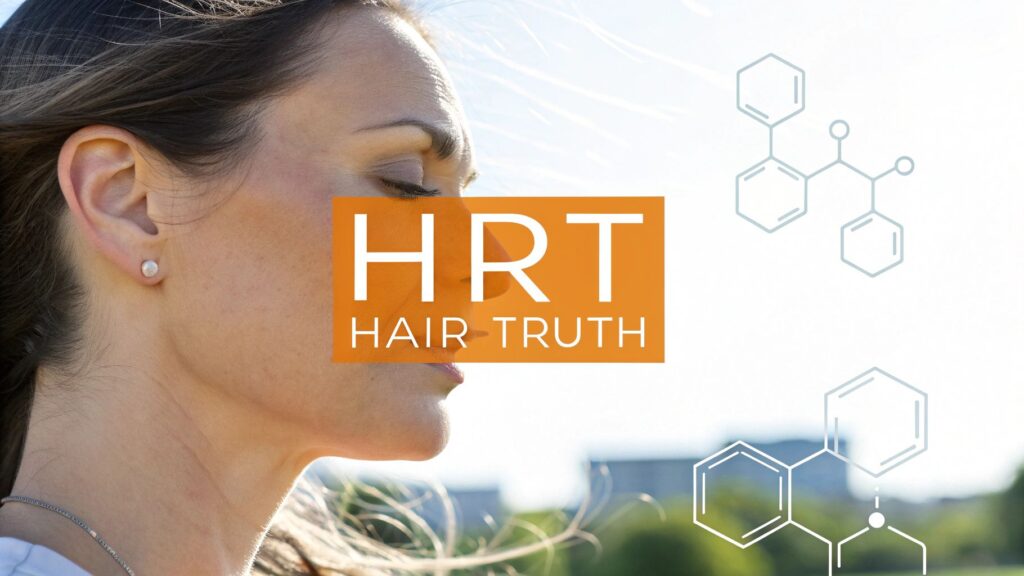
When people ask whether hormone replacement therapy causes hair loss, they’re usually hoping for a simple yes or no. The truth is, it's not that straightforward. For some, certain types of HRT can contribute to hair thinning, but for others, it might have no effect at all—or could even improve hair health. The outcome is deeply personal and hinges on a few key factors.
The Complicated Truth About HRT And Hair Loss

Starting hormone replacement therapy (HRT) often comes with a list of questions, and the potential impact on your hair is usually near the top. It’s a valid concern, but the reality is far more nuanced than a direct cause-and-effect relationship. How HRT affects your hair is less of a one-size-fits-all problem and more of a personal puzzle.
Think of it as a combination of three critical pieces:
- Your Genetic Blueprint: Your inherited sensitivity to certain hormones plays the biggest role.
- The Specific HRT Formula: Not all hormones are created equal, and their effects on hair follicles can differ dramatically.
- Your Pre-Treatment Hair Health: The condition of your hair before you start therapy sets the stage for how it will respond.
Why The Answer Is So Complex
The relationship between HRT and hair is tricky because the scientific data can feel contradictory. This is mostly because studies have looked at a wide variety of hormone formulations, and every person’s body reacts differently.
While estrogen and progesterone therapies are common, their precise impact on hair health is still not perfectly defined without large-scale studies focusing specifically on hair outcomes.
To make things even clearer, here are the main variables that determine whether you might experience hair changes while on hormone therapy.
Key Factors Influencing HRT's Effect on Hair
This table summarizes the primary variables that determine whether an individual might experience hair changes while on hormone replacement therapy.
| Influencing Factor | How It Affects Hair on HRT | Example |
|---|---|---|
| Genetic Predisposition | If you have a family history of androgenic alopecia (pattern baldness), you may be more sensitive to hormonal shifts, including those from certain progestins in HRT. | A woman whose mother and grandmother experienced significant hair thinning might be more susceptible to HRT-related hair changes. |
| Type of Progestin | Some synthetic progestins have androgenic properties, meaning they can act like testosterone in the body and shrink hair follicles. Others are non-androgenic. | Progestins like levonorgestrel can be more androgenic, while natural progesterone or dydrogesterone are generally considered hair-neutral or hair-friendly. |
| Dosage and Balance | The balance between estrogen and progesterone/progestin is key. Too much of an androgenic progestin relative to estrogen can tip the scales toward hair thinning. | A high dose of an androgenic progestin combined with a low dose of estrogen could be more problematic than a balanced, lower-dose formula. |
| Underlying Health | Pre-existing conditions like thyroid disorders, nutritional deficiencies (e.g., low iron or vitamin D), or high stress levels can make hair more vulnerable to hormonal changes. | Someone already dealing with low ferritin levels may be more likely to notice hair shedding when starting any new hormonal regimen. |
Understanding these individual factors is the first step toward working with your doctor to find a treatment that works for your whole body—including your hair.
The key takeaway here is that your personal response to HRT is what matters most. While some may experience changes, many women find that the benefits of balancing their hormones far outweigh any potential side effects.
Ultimately, the goal is to understand that the connection isn't always direct. Many things contribute to hair health, especially during the transition into menopause. By exploring the different types of treatments, such as bioidentical hormone replacement therapy, you can have a much more informed discussion with your doctor. This knowledge empowers you to find a solution that supports your overall well-being without compromising your hair.
How Hormones Govern Your Hair Growth Cycle
To get to the bottom of how hormone replacement therapy might lead to hair loss, we first need a quick look at how your hair works day-to-day. Your hair's lifecycle isn't one long, continuous process of growth. Instead, it moves through three distinct phases. Understanding this natural rhythm is the key to seeing why a sudden hormonal shift can throw the whole system off balance.
Let's use an analogy: think of your scalp as a busy garden. Each hair follicle is a plot of soil, and your hormones are the gardeners, each with a very specific job. This "garden" is constantly cycling through its seasons:
- Anagen Phase (Growing): This is the active, bustling growth period where your hair gets longer. It's a long season, lasting anywhere from two to seven years.
- Catagen Phase (Transitioning): A very brief, two-week phase where the hair follicle shrinks and disconnects from its blood supply, preparing to rest.
- Telogen Phase (Resting): The follicle lies dormant for about three months. At the end of this phase, the old hair sheds, and a new one begins its journey, restarting the anagen phase.
The Gardeners: Estrogen and Androgens
In our garden analogy, your primary hormones act as powerful gardeners, directly influencing how long each of these phases lasts. Estrogen is like a super-fertilizer for your hair. It helps extend the anagen (growing) phase, which is exactly why many women notice their hair feels thicker and fuller during pregnancy when their estrogen levels are sky-high.
On the flip side, certain androgens (a group of hormones that includes testosterone) can sometimes act like a persistent weed in the garden. The main culprit here is a potent androgen called dihydrotestosterone (DHT), which becomes a problem for people with a genetic sensitivity to it.
When testosterone gets converted into DHT in the scalp, it can bind to receptors in the hair follicles, causing them to shrink. This process, known as miniaturization, shortens the anagen phase and results in finer, weaker hairs with each new cycle. Over time, the follicle may stop producing hair altogether.
It’s this delicate dance between growth-promoting estrogen and potentially follicle-shrinking androgens that keeps your hair healthy. Any sudden change—like the hormonal freefall of menopause or the introduction of HRT—can disrupt this balance, sometimes leading to unwanted changes in your hair's density.
The following infographic illustrates how different types of HRT can sway this process, potentially triggering hair loss in some users.
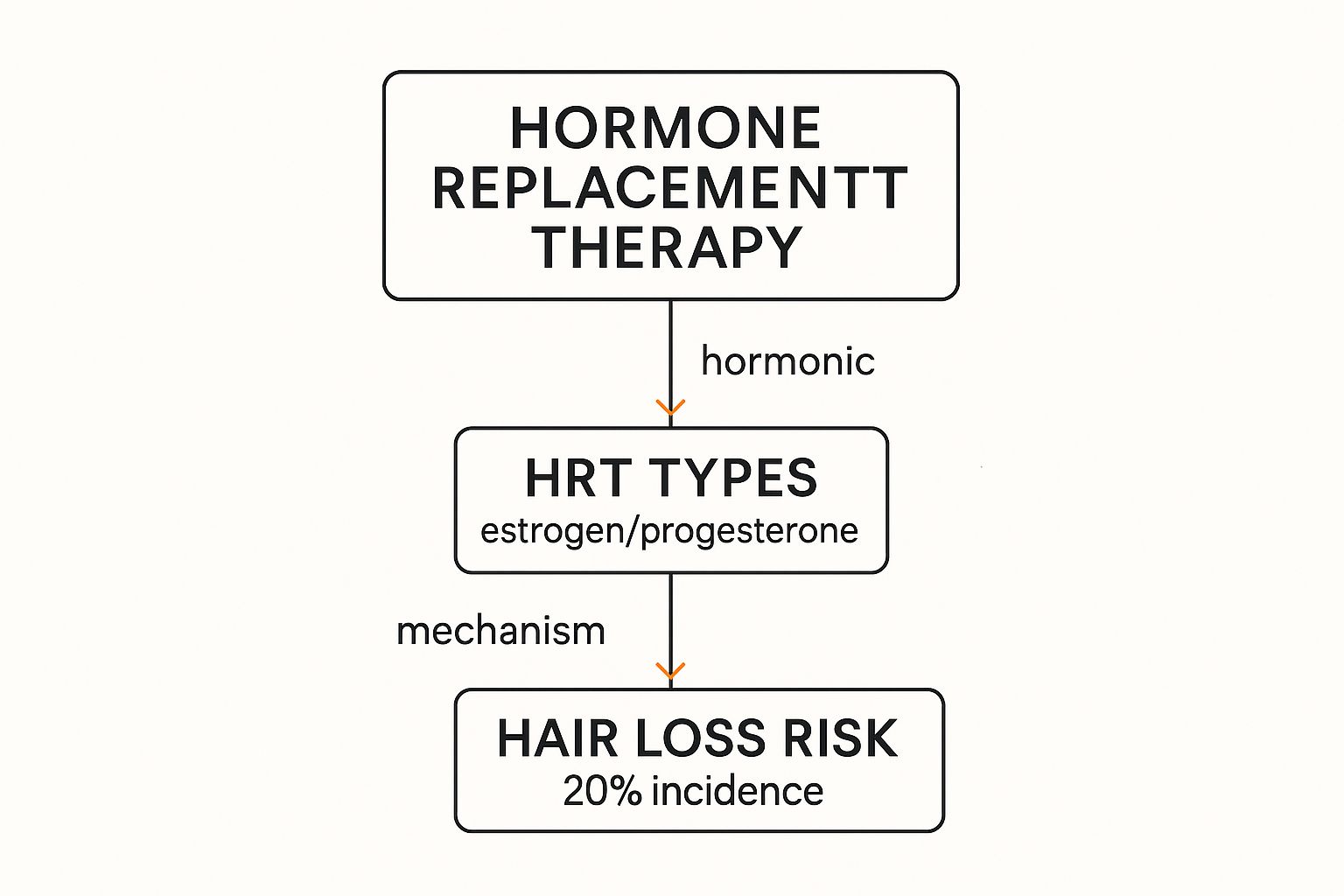
As this visual shows, the risk isn't the same for everyone. It's tied to how the specific hormones in an HRT formula interact with your body’s unique chemistry, especially that conversion of testosterone to DHT. Grasping this core mechanism is the first step in understanding why the question "does hormone replacement therapy cause hair loss" has such a nuanced answer.
Why The Type Of HRT You Take Matters

When you're trying to figure out if hormone replacement therapy can cause hair loss, it's easy to get confused. The most important thing to understand is that not all HRT is created equal. Thinking of "HRT" as one single thing is a huge mistake; it's a broad category of treatments with very different formulas and, therefore, very different effects on your hair.
Your prescription will generally fall into one of two camps: estrogen-only therapy, or a combination formula that includes both estrogen and a progestin. While estrogen is almost always great for your hair—helping to keep strands in their growth phase longer—the type of progestin in the mix is where the trouble can start.
The Role Of Progestins And Androgenic Activity
The crucial detail here is the androgenic activity of the progestin. Some synthetic progestins, also known as progestogens, have a molecular shape that looks a lot like male hormones, or androgens.
Imagine your hair follicles have tiny keyholes, or receptors, that are meant for androgens like DHT. Certain synthetic progestins are like a poorly cut key—they weren't designed for that specific lock, but they can wiggle their way in and turn it just enough. When that happens, they can set off the same hair-miniaturizing process as DHT, leading to thinner hair over time.
This is the single most important distinction to grasp before talking to your doctor. Knowing that not all progestins are the same gives you the power to ask for hair-friendly options.
Key Insight: The risk of hair thinning from HRT usually isn't from the therapy in general, but from the androgenic effects of a specific synthetic progestin in the formula. Choosing a non-androgenic or even anti-androgenic progestin can make a world of difference.
For instance, micronized progesterone, which is molecularly identical to the progesterone your body produces naturally, is widely considered hair-neutral or even beneficial. Other synthetic versions, however, have much higher androgenic profiles.
Different Hormones, Different Effects
Let’s break down how the different hormones in an HRT formula typically impact your hair:
- Estrogen: Almost always a win for your hair. It extends the anagen (growth) phase, which helps your hair grow longer and feel fuller.
- Micronized Progesterone: This is generally seen as neutral or slightly positive for hair health. It doesn't have the androgenic side effects that some synthetics do.
- Androgenic Progestins: These are the potential culprits. In people who are genetically predisposed to hair loss, these can latch onto androgen receptors in the scalp and contribute to thinning.
- Testosterone: The role of testosterone is often misunderstood. While it can convert to the hair-follicle-shrinking DHT, many women become deficient in testosterone during menopause. In a surprising 2011 study on women with androgen deficiency, over 63% of those who already had hair thinning actually saw hair regrowth after starting testosterone therapy. This suggests that for some, rebalancing low testosterone is actually good for hair. You can explore the study's findings on testosterone and hair growth.
At the end of the day, knowing that the specific formula is what truly matters allows you to have a much more productive conversation with your doctor. You can work together to find a type of HRT that manages your menopausal symptoms without making you sacrifice your hair.
When you start a new treatment like hormone replacement therapy and then notice your hair thinning, it's completely natural to connect the two. And while HRT can be a factor, it’s rarely the only suspect in the lineup. Hair loss in midlife is often a case of "multiple culprits," where several different issues are all happening at once. Before you even think about stopping a therapy that might be giving you crucial health benefits, it’s important to zoom out and look at the bigger picture.
It’s just human nature to blame the newest variable, but menopause itself is a period of massive upheaval for the body. The intense hormonal shifts during this life stage can trigger hair issues all on their own, completely separate from any treatment you start. The first real step toward finding a solution is learning to tell these factors apart.
Unmasking The Other Suspects
Think of your hair's health as a delicate ecosystem. HRT might be a new element introduced to it, but other forces could be disrupting the balance at the very same time. Many women are surprised to learn that what they assume is a bad reaction to HRT is actually one of these common, overlapping conditions.
Let’s investigate some of the most frequent hair loss triggers that show up right around the menopausal transition:
- Telogen Effluvium (TE): This is a type of temporary, all-over shedding that’s kicked off by a major physical or emotional stressor. Think menopause itself, major surgery, or a significant life change. The hormonal whiplash and stress of this period can shock a huge number of hair follicles into the resting (telogen) phase all at once, leading to very noticeable shedding about three months later.
- Nutritional Gaps: As we get older, our body's ability to absorb key nutrients can take a nosedive. Deficiencies in hair-building essentials like iron (specifically ferritin), vitamin D, zinc, and B vitamins are incredibly common and can directly cause hair to fall out.
- Thyroid Issues: Your thyroid is the master regulator of your metabolism, and it has a direct line to your hair growth cycle. Both an underactive thyroid (hypothyroidism) and an overactive one (hyperthyroidism) can cause widespread hair thinning. It’s no coincidence that thyroid problems often first appear during midlife, making them a very common troublemaker.
It's crucial to remember that you're not alone in this. Hair loss is a widespread issue, affecting a huge portion of the female population. In fact, data shows that 33% of women experience some form of hair loss in their lifetimes, often tied to major hormonal shifts like menopause. You can learn more about hair loss statistics and triggers to see just how common it is.
The Natural Progression Of Pattern Hair Loss
Finally, we have to talk about the elephant in the room: androgenetic alopecia, much more commonly known as female pattern hair loss. This is a genetic condition that can either switch on for the first time or speed up dramatically as estrogen levels fall during menopause.
With less estrogen around, the relative impact of androgens (like DHT) on your hair follicles becomes much stronger. This causes them to shrink over time, producing thinner, finer, and weaker hairs with each new growth cycle. This condition would happen with or without HRT.
By working with your healthcare provider to identify and address these other potential causes, you can get a much clearer diagnosis. This allows you to pursue the right treatment, making sure you don’t needlessly give up a therapy that is otherwise helping you feel your absolute best.
Proactive Steps To Protect Your Hair On HRT
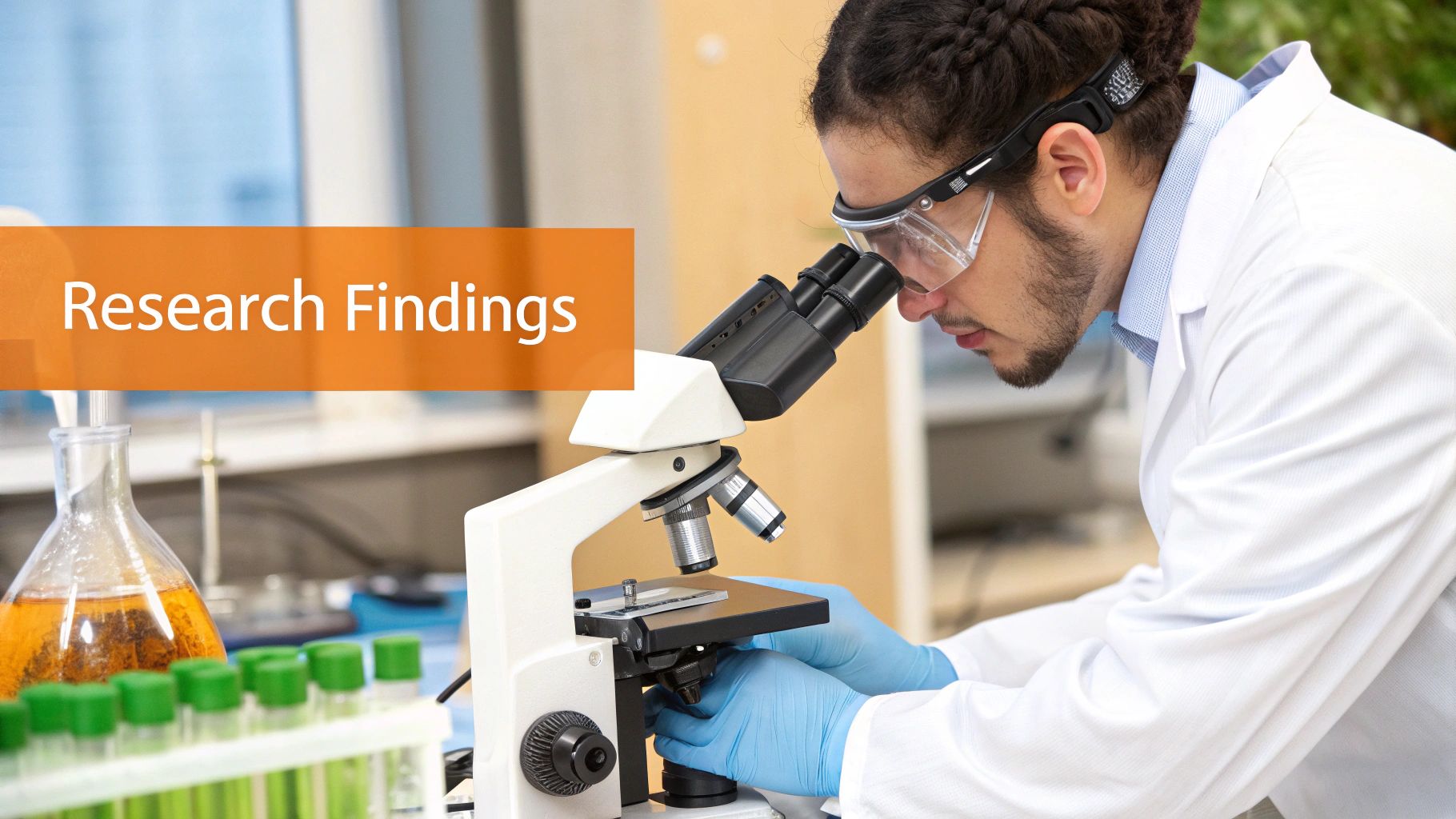
If you’re worried about your hair thinning while on hormone replacement therapy, the most important thing to know is that you have options. You don't have to choose between the benefits of HRT and the health of your hair. Taking a few proactive steps can make a world of difference, putting you back in control.
The single most powerful move you can make is to have an open, honest talk with your doctor. They can't help if they don't know you're concerned. A simple conversation about your hair can lead to small but significant adjustments to your HRT formula that often resolve the problem completely.
Partner With Your Doctor
Think of your doctor as your greatest ally in this process. The goal isn't to abandon your therapy—it's to fine-tune it. Now that you understand that some synthetic progestins have androgenic activity, you can have a much more specific and productive conversation.
Ask your doctor about switching to a formula with a lower androgenic profile. For example, options like micronized progesterone are often called "hair-friendly" because they don't mimic the follicle-shrinking effects of androgens. This small tweak can be enough to halt shedding and, in many cases, even encourage regrowth.
Key Action: Book a follow-up appointment with the specific goal of discussing your hair. Don't just mention it in passing. Frame the conversation around finding a "hair-friendly" HRT formula. This collaborative approach almost always leads to a better outcome for both your hormonal health and your hair.
Support Your Hair From The Inside Out
While adjusting your prescription is the primary fix, you can also build up your hair’s resilience from within. Think of it as creating a strong foundation. When your hair is well-nourished, it's better equipped to handle any hormonal shifts.
A nutrient-rich diet is absolutely non-negotiable for healthy hair. You need to supply your body with the right building blocks.
- Protein Power: Your hair is made almost entirely of a protein called keratin. Make sure you're eating plenty of lean meats, fish, eggs, and legumes.
- Essential Nutrients: Load up on foods rich in biotin (like nuts and seeds), iron (like spinach and red meat), and zinc (like oysters and pumpkin seeds).
- Manage Stress: Chronic stress floods your body with cortisol, a hormone that can push more of your hair into the shedding phase. Simple stress-management techniques like meditation, yoga, or even a daily walk can help keep your hair in its healthy growth cycle.
Consider Proven Topical Treatments
For an extra layer of defense, you can add a proven topical treatment to your daily routine. It’s a great way to support the follicles directly while your internal hormones get balanced.
One of the most well-known and effective options is minoxidil. It works right on the scalp to wake up sluggish hair follicles, helping to shorten their resting phase and extend their growth phase. It’s an excellent supportive therapy that works alongside your HRT adjustments to encourage new growth and improve the density of the hair you already have.
Making An Informed Choice For Your Health And Hair
Grappling with the question, "does hormone replacement therapy cause hair loss?" can feel like you're caught in a tough spot. But it really comes down to how you frame the decision. This isn't about choosing between your overall health and the health of your hair. The reality is that for the overwhelming majority of women, HRT is not a major cause of significant hair thinning.
The conversation should really be about weighing the profound, life-changing benefits of HRT against a small—and usually manageable—risk of hair changes. For so many women, the relief from debilitating hot flashes, a stabilized mood, and stronger bones easily outweighs a potential side effect that can often be fixed with a simple prescription adjustment.
Partnering For Your Best Health
The ultimate goal here is to find a personalized solution that supports your entire body, not just one part of it. This journey is a partnership between you and a healthcare provider who truly understands hormone balance. It all starts with an open, honest conversation about your goals and concerns, which allows your doctor to fine-tune your treatment.
The key takeaway is this: you do not have to sacrifice your hair to feel your best. The right approach involves finding a balance that addresses your menopausal symptoms while protecting your hair.
A well-designed plan might involve choosing a "hair-friendly" progestin or making sure your hormones are dosed correctly for your specific needs. By understanding the different options available, like the various forms of hormone therapy for women, you can confidently advocate for a treatment that aligns with all of your health goals.
This collaborative approach is empowering. It ensures your HRT journey not only helps you navigate the challenges of menopause but also helps you feel vibrant, confident, and healthy—from head to toe. You really can achieve hormonal harmony without compromising the hair you love.
Your HRT and Hair Questions, Answered
As you get deeper into your HRT journey, it's natural for specific questions to pop up. Moving from general knowledge to your personal situation can feel a bit overwhelming, so let's clear up some of the most common worries with straightforward, expert answers.
If HRT Causes Hair Thinning, Is It Permanent?
This is usually the first question on everyone's mind, and the answer is often a sigh of relief. If your hair thinning is a direct result of an androgenic progestin in your HRT formula, the effect is typically reversible.
Once you and your doctor pinpoint the issue and switch your prescription to a more hair-friendly alternative, the excessive shedding usually stops. Over time, your hair can regrow. It’s crucial, however, to separate this from the natural progression of androgenetic alopecia (female pattern hair loss), which is an underlying genetic condition that will continue on its own path, regardless of HRT.
Will Bioidentical Hormones Prevent Hair Loss?
The term "bioidentical" can be a bit of a red herring. It simply means the hormone’s molecular structure is a perfect match for the ones your body produces naturally. It is not an automatic get-out-of-jail-free card for hair loss.
What really matters is the specific hormone's androgenic potential—its tendency to act like a male hormone. For instance, bioidentical micronized progesterone is widely considered hair-friendly. But on the flip side, bioidentical testosterone is, by its very nature, an androgen and can still convert to DHT, the main culprit behind shrinking hair follicles. Always focus on the type of hormone, not just the "bioidentical" label.
How Long After Starting HRT Might I See Changes?
Patience is your best friend here. Your hair’s growth cycle is a slow, methodical process, and any changes—good or bad—won't happen overnight. It typically takes a solid three to six months to notice a real, tangible difference after starting or tweaking your HRT.
Knowing this timeline can save you a lot of stress over normal, daily shedding. It's also wise to be aware of other potential hormone replacement therapy side effects and bring up any concerns with your doctor. Keeping a realistic timeframe in mind lets you accurately gauge how your body is responding without jumping to conclusions based on short-term ups and downs.
At Elite Bioscience, we believe in empowering you with the knowledge to make confident health decisions. Our tailored hormone, peptide, and vitamin therapies are designed to support your wellness goals with clarity and precision. Explore our solutions at https://elitebioscience.co and take the next step toward a more vibrant you.
QUICK SEARCH
Make an account today to start your journey towards a better and healthier lifestyle.




